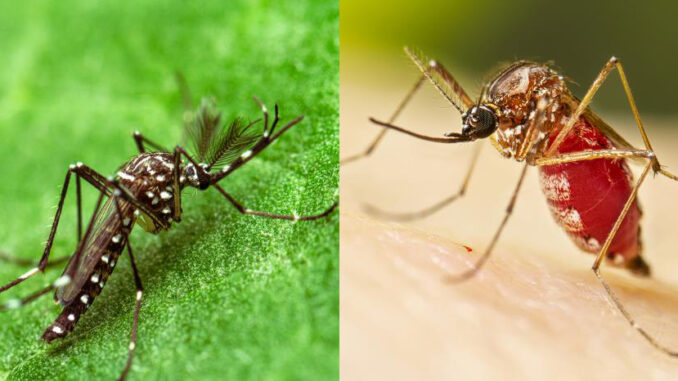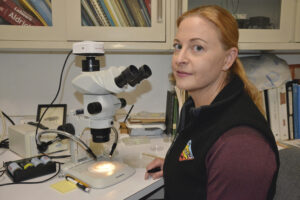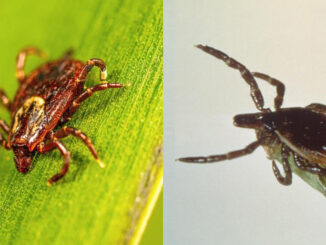
Mosquito species in Santa Barbara County vary by habitat, behavior, and disease risk—knowing the difference can help prevent bites and protect public health
by Elizabeth Ann Morabito
Did you know Santa Barbara County is home to 16 different mosquito species? While most people think of mosquitoes as a single nuisance, each species has its own behaviors, breeding preferences, and health risks. Some bite aggressively during the day, others only at night. Some thrive in wooded areas, while others multiply in floodwaters or backyard containers.
If we get Aedes aegypti here, we have to act fast. The sooner it’s reported, the better chance we have of preventing it from becoming established.
Karen Schultz, vector biologist technician at MVMD
Educating residents about which mosquitoes are active, where they breed, and what threats they pose helps the Mosquito & Vector Management District of Santa Barbara County (MVMD) target its control efforts more effectively. Local mosquitoes fall into five main groups:
Tree Hole & Snow Pool Mosquitoes
- Breed in: Water-filled tree holes, rock crevices, snow melt pools
- Found in: Los Padres National Forest, Santa Ynez Mountains, foothills
- Active: Daytime; early spring through summer
- Look like: Dark-colored with white leg bands
- Risk: Primary vector of heartworm
Salt Marsh Mosquitoes
- Breed in: Coastal salt marshes and wetlands flooded by high tides
- Found in: Carpinteria Salt Marsh, Goleta Slough, areas near UCSB’s lagoon
- Active: Daytime; spring through fall
- Notable behavior: Swarm in large numbers, bite aggressively
Freshwater Mosquitoes
- Breed in: Standing water in ponds, ditches, and storm basins
- Found in: Agricultural zones and storm water basins countywide
- Active: Dusk through nighttime; spring to late fall
- Look like: Small-sized
- Notable behavior: Active in the evening
- Risk: Known carriers of West Nile Virus and other serious illnesses
“Freshwater mosquitoes are some of the biggest threats because they can carry dangerous diseases. The best way to prevent outbreaks is to eliminate standing water where they breed,” warns Karen Schultz, vector biologist technician at MVMD.
Floodwater Mosquitoes
- Breed in: Dry stream beds, fields, floodplains that refill with rain
- Found in: Santa Ynez River area, Lompoc Valley fields, lower-lying areas
- Active: Day and evening, late winter through summer
- Notable behavior: Aggressive biting after heavy rains
Small Container Mosquitoes
- Breed in: Birdbaths, flower pots, rain barrels – anything holding stagnant water
- Found in: Urban/suburban areas across Santa Barbara, Goleta, and Montecito
- Active: Primarily nighttime; year-round, peaking in summer and fall
- Risk: Several species can transmit West Nile Virus
Though not currently established in Santa Barbara County, another container mosquito is spreading quickly throughout southern California, the Central Valley, and into northern California. Aedes aegypti, nicknamed the ‘ankle biter,’ bites during the day, can breed indoors, and prefers humans.
Specific Small Container Mosquito: Aedes aegypti
- Breed in: Outdoors – anything that holds water; indoors – small spaces holding even just a tablespoon of water such as tooth brush holders, coffee makers, and water coolers
- Found in: Urban/suburban areas, in yards, and oftentimes inside homes
- Active: Daytime; year-round, peaking in summer and fall
- Look like: Small black body with white markings on legs and lyre pattern on thorax
- Notable behavior: Targets legs, especially the ankles; thrives in human environments
- Risk: Can spread Zika, dengue, chikungunya, and yellow fever viruses
Its spread is often fueled by everyday human activity. One theory suggests it was introduced to California through shipments of Lucky bamboo from Asia. But it doesn’t take international trade to pose a risk. Routine moves and weekend travel can do the same.
“If somebody’s moving from the Los Angeles area up here and they have a bunch of flower pots or something that has the eggs on them, next time you get a good rain between May and October, then they’ll hatch out again,” warns Brian Cabrera, MVMD general manager. “So yeah, it’s a big worry for me.”

lookout for Aedes aegypti, an invasive mosquito
species present in nearby areas
Photo credit Nell Campbell
“If we get Aedes aegypti here, we have to act fast. The sooner it’s reported, the better chance we have of preventing it from becoming established,” Schultz emphasizes.
MVMD urges residents to report any unusual mosquito activity. Community reports help identify emerging patterns and enable the District to respond quickly and effectively.
“We can’t be everywhere,” Schultz says, emphasizing how hearing from residents helps them map out mosquito hot spots and respond more effectively.
How you can help keep Santa Barbara County safe:
- Spot unusual mosquito activity? Especially daytime ankle biters? It could be invasive Aedes aegypti—report immediately: mvmdistrict.org/contact-us or call (805) 969-5050.
- See standing water or a neglected pool? Let MVMD know: mvmdistrict.org/contact-us or call (805) 969-5050.
- Found a dead bird? It may be linked to West Nile Virus. Report it to the California Department of Public Health: westnile.ca.gov/report.



